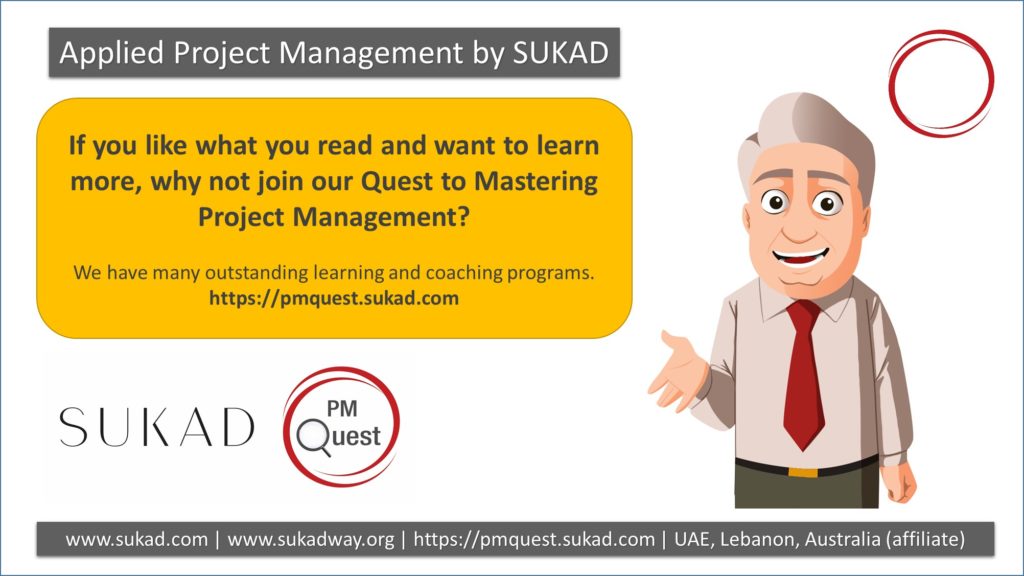What are the possible PMO functions? In the context of this article, a PMO can be a project or a program management office. Today, we discuss eight possible functions along the PMO Continuum.
In the previous article we established:
- The PMO, typically, is for the organization and not for one project or program
- The PMO, typically, is an organizational unit
- Not all PMO’s are the same
- PMO typically stands for Project Management Office or Program Management Office
A few more words about PMO
Today we add
- A PMO may consist of as little as two team members or many more.
- Many organizations could have a PMO but they do not call it PMO. They might use the terms Project Management Unit or Department; or other terms. For the purpose of this article, we will consider these as PMO’s.
With the above in mind, what are the role and functions of the PMO?
 As we said before, the topic is quite open and there are many variations. We present our views on the roles and functions of a PMO via the SUKAD PMO Continuum. We also cover these topics in a learning program that we offer under the title Building the Program Management Office.
As we said before, the topic is quite open and there are many variations. We present our views on the roles and functions of a PMO via the SUKAD PMO Continuum. We also cover these topics in a learning program that we offer under the title Building the Program Management Office.
The PMO Continuum
The PMO Continuum is the way that we (at SUKAD) represent the various functions and roles (focus) of PMO within an organization. What we present below is likely to be in a logical order but since not all organizations are alike, the order we present below is not likely the sequence that all organizations follow.
One: Passive Reporting
The most basic form and role of a PMO could be what we might call ‘Reporting PMO’. This PMO would be responsible for collecting reports from the various projects and programs, collating and summarizing them, then forward a summary report to the organizational management for review.
Two: Active Reporting
Ideally, one could present that since the PMO is responsible for reporting, then the PMO should also standardize the reports used by the projects and programs. Therefore, an active reporting PMO is a PMO that would establish standard guidelines for the project managers on the various required reports.
Three: Training Support
If an organization starts to empower their PMO beyond the basic functions, then the PMO could be responsible for reporting, in addition to training and development of project management personnel. The idea here is not for the PMO to replace Human Resources or Learning & Development but for the PMO to work with Learning & Development to recommend the right professional learning programs for the organization staff in the domain of project management.
Four: Career Management
The next logical level could be for the PMO to assume responsibility for career management.
In this case, establish formal job descriptions and career paths for project management personnel across the organization. This includes a professional development program that consists of a mentoring and coaching program.
Five: Project Coordination
In some organizations, the PMO might handle coordination of all or some of the organization projects. The focus here is not on managing the projects but possibly coordinate between projects and manage the interfaces.
Six: Project Management System
One of the most important functions of a PMO, in our humble opinion, is for the PMO to assume responsibility for the project management system in the company. Basically, establish the right project management methodology and processes such as: how to approve projects, how to launch or initiate projects, how to plan for projects, and how to manage and control projects. A project management system also includes the proper project life cycle model, definitions of project stages and stage gates, and a ‘lessons learned’ system.
The PMO should also assume responsibility for the historical databases (may be included in reporting) and records for projects? What are the Performance Metrics for projects?
Some readers might argue, “what you describe here is given” all PMOs must be doing this, are not they?” Unfortunately no.
Seven: Managing Projects and Programs
In certain organizations, the PMO could also be the project management functional home for the career project managers and project management personnel. When there is a project, the organization will pull the project manager from the PMO and other project resources and team members will come from the other functional department. For those who have good knowledge in project management organizational structure, this is what we call a strong matrix organization.
Eight: Strategic Project Management
This eighth possible function will be the subject of a separate article.
Some questions for you
- Do you agree with some (or all) of what we share here?
- If you have a different view, please let us hear from you
- If you are in a PMO or have expertise in this area – what are some of the challenges and opportunities that you have encountered?
- Do you think PMOs are important or just a fad/trend?



From my experience I can say that, the first challenge PMO s are as in every PM function is the corporate support they get. This impacts the role(s) and influence; from a simple coordinating PMO with no budget to expand and hence set in a career path and chance to develop staff and promote the PMO approach to a PMO playing a central role in aligning corportate strategy and objectives with the PM Portfolio or Programs.
Another major challenge is that establishing a PMO can mean a major corporate change on how business is conducted today. Change doesn’t occure immediatly; it needs time and expectations have to be “agreed” upon in order to be able and assess success.
Also KPIs to judge progress prove to be a challenge when quantative measures like time are not applicable because the amount of changes asked for by stakeholders. Dasboards are expected to report on a Program level and solid measures or benchmarks (quantative) vs qualitative can be very challenging. This can impact the PMOs reporting credibility severely.
Hi Ahmed
Thank you for the contribution.
We agree that PMO + PM System is a major organizational change with significant resistance from various stakeholders. This is one reason we recommend an extended approach and a program management approach for implementing the organizational change.
This comment is By Michelle McKinnon, PMP • on LinkedIn:
This was a good article and I agree that the 8 functions presented is/has been the traditional function(s) of a PMO. The PMO function needs to evolve to focus more on planning at the strategic level – before projects become active from a business execution stand point.
I firmly believe that we are on the cusp of business change that will occur in the next 5 to 10 years that will differentiate successful profitable organizations, which means this is a very exciting time.
This comment is By Haydn Thomas – PMP, MPC on LinkedIn:
Michelle, I agree with you on being on the cusp. The question needs to be raised, is that what this new Title/Role of Change Manager is trying to achieve with holistic product/service lifecycles that incorporate the project lifecycle. Change managers appear before project initiation, during the project and after the project has been delivered to operations in ensuring the project delivers and sustains the benefits and outcomes for the organisation.
Michelle
What you propose is the eighth function of the PMO which is the most important in my view. Unfortunately, i did not elaborate on this point in the article.
I really like the basic structure and approach taken there. I just have one plea; where you write in Six that the function of a PMO is to:
“… establish the right project management methodology and processes such as: how to approve projects, how to launch or initiate projects, how to plan for projects, and how to manage and control projects. A project management system also includes the proper project life span model, definitions of project stages and stage gates, and lessons learned system.”
it would be much better if you acknowledge that there is no “one size fits all” approach to project management. PMOs so often force projects to use methodologies that at best do nothing but add bureaucracy, and at worst actively reduce the possibility of success for a project.
Classic example: the full application of PRINCE2 to small projects with evolving requirements which would be far better dealt with light-touch governance and an agile methodology such as Scrum. I’ve seen so many PMOs that get hung up on enforcing a standard methodology when it would be better to focus on a simple standard reporting format that could adapt to a variety of execution methodologies.
Not all methodologies are created equal, but at least recognising the possibility that a suite of recommended options might be more robust than one-size-fits-all would be a big step forward for PMOs.
Dear Stephen
We are in total agreement with you on “one size fits all”. Although, this point is not clearly stressed here please refer to:
(1) This topic “one size fits all” is one of the challenges facing management that we addressed in one of our ebooks and in a blog article http://blog.sukad.com/20130328/6-challenges-is-one-size-fits-all-appropriate-for-project-management/
(2) SUKAD has developed a methodology (the subject of our ebooks) that we call The Customizable and Adaptable Methodology for Managing Projects (CAM2P) … this is specifically related to the question of one size (DOES NOT) fits all; here is a link to a brief on CAM2P http://sukadway.sukad.com/introduction-to-the-cam2p-model
For our ebooks, you can download free copies from: http://knowledge.sukad.com/ebooks
This comment is By “Ari” Arivazhagan, PMP, PMI-SP,PMI-RMP,MBB on LinkedIn:
I have several comments to offer. However, let me start with the Ninth function first, as I think, this can be one of the important functions of a PMO.
Ninth: Knowledge Management (KM)
Many project-based companies are poor at this function and they miss a lot of knowledge, that otherwise could have been converted into company’s process assets, due to lack of awareness in this direction. ( or possibly due to short-term focus).
This is clearly a leadership failure in many organizations.
Knowledge Management essentially could comprise three or four sub-functions.
#1. Structured Documentation of Lessons Learned.
#2. Institutionalization of Lesson Learned.
#3. Developing Preventive Actions.
#4. Archiving the Lessons Learned.
Irrespective of the type of a PMO, this function should form one of the core functions of any PMO.
This comment is By Mathews Srampikal,PMP,PMI-RMP on LinkedIn:
Good Article…
Ari, I believe all 4 points and KM, are very clearly covered in the articles 3rd,4th and 6th functions. Any thoughts?
Knowledge Management, Risk Management, Change Management is embodied in the various functions at different levels. However, if you review our organizational project management model, which is wider and more comprehensive then the PMO, Knowledge Management and Organizational Learning are one of the essential Seven Elements of Project Management Maturity.
Please refer to the model on this link (http://sukadway.sukad.com/introduction-to-the-sukad-maturity-model) … also refer to the image on the link (first ring from the inside)
certainly like your web-site however you need to check the spelling on several of your posts.
Many of them are rife with spelling problems and I find it very bothersome to tell the truth however I’ll definitely come again again.